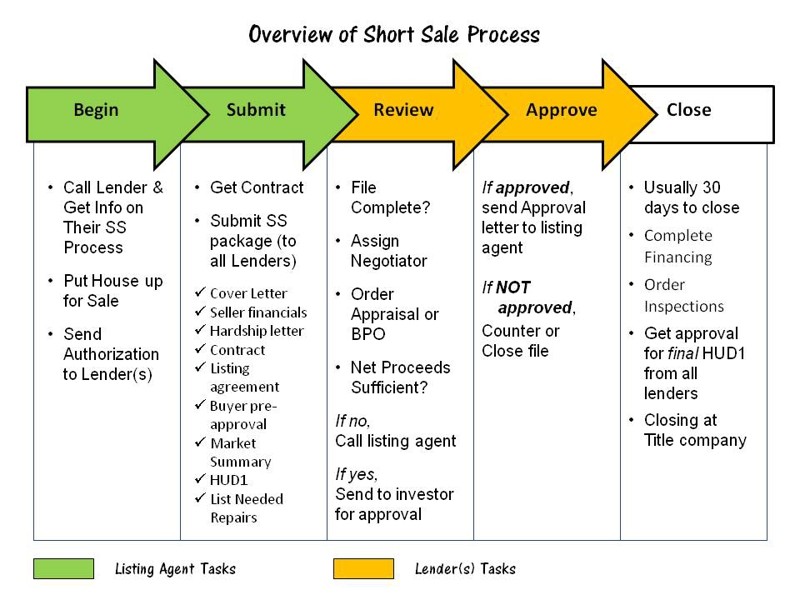Short Sale Process
Post on: 18 Июль, 2015 No Comment

The short sale process is fairly simple to understand if you have any experience with real estate. Let’s go through the different steps in a short sale so you know exactly what you are getting yourself into.
The short sale process starts when a homeowner is delinquent at least 90 days and has been issued a notice of default. The lender is now in a position to accept less than what is owed on the mortgage. The investor or real estate agent handling the short sale will need to sign an authorization to release form that will be sent to the lender giving them permission to speak to the lender on the homeowners behalf.
Once the authorization is faxed to the lender, whether you are the investor or a real estate agent will request a short sale packet or workout packet. You should also get the direct number of the person who is handling the account which will save lots of time and headache in the weeks to come. Next in the short sale process is checking title. If you have a relationship with the title company, you can run a preliminary report at no cost. This allows you to see if there are any liens against the property.
Short sale requirements
Once you have short sale packet from the lender, you’ll need to make sure it’s filled out completely. Any incomplete packets will delay the process and get rejected. The following short sale requirements are typically what a lender wants to see:
- a purchase and sale agreement
- a hardship letter
- bank statements
- tax returns
- a financial statement
- HUD-1 settlement
- and possibly a listing agreement

If you have any supporting documents, might as well send those as well. Once you complete the necessary short sale requirements the lender requested, you’ll send back the packet along with your offer. If you don’t have certain documents that were requested, you must explain why. If they don’t receive what they ask for, they’ll just toss it aside and move to the next file.
Finding the Buyer
Next in the short sale process is finding the buyer. If you’re an investor, finding a cash buyer is by far the best option but there may be times you need to settle with a buyer who needs financing. For some, finding the end buyer seems to be the hardest part. However, it should be one of the easiest parts because you should be buying this property for considerably less than it’s market value. It’s not uncommon to pick up homes .60 on the dollar. If there is a 2nd mortgage, banks will usually accept .10 on the dollar and many times even less than that depending on the deal.
There are several ways of finding buyers. If you haven’t started creating a buyers list it’s time to start. You can start by calling all the bandit signs you see in your neighborhood or on street corners that say, We Buy Houses. Next, call all the landlords that have properties close by. Call up property managers in the area, find out who is buying properties. Go to your local real estate group or investor club. See who is looking for great deals. Advertise in your local newspaper that you have a handyman special. You’ll be surprised how quickly your list grows and how easy it is to find buyers and repeat buyers.
Planning Your Exit Strategy
As with any real estate deal, when you are doing a short sale, you need to know your exit strategy before you even make the offer. In most cases, investors like to use transactional funding because they don’t have to use their own money to bring to closing, regardless if they have it or not. Transactional funding allows you to perform the sale between you and the bank and then allow you to sell it to your end buyer. If you are an agent, the process is very similar. If you don’t want to be in on the investor side, you just need to find a home buyer who can qualify for the loan and a typical short sale will pay 3% — 5% commission.
Short sale BPO
The BPO comes next in the short sale process. This is a brokers price opinion where an appraiser appointed by the bank will come out to the property to give the bank his/her opinion on what the home is worth. Usually you’ll want to meet the appraiser at the home so you can walk through all the problems and point out all the flaws or repairs needed. The goal is to get the BPO to come in low. Show up with a list of repairs, low comps and other supporting documents so you can give it to them. Sometimes they like that, other times they just look at you funny and tell you no thanks. Then you play the waiting / follow up game. You’ll want to pay close attention to the auction date and really be proactive in knowing the status of the short sale being accepted.
Once the short sale is accepted, you’ll receive a payoff letter and schedule your closing. Make sure you’ve either got funding in place if you’re an investor or your end buyer if you’re an agent. That’s about all there is to it to the short sale process. You can expect anywhere from 4-6 months and sometimes longer to complete a short sale because of the number of short sales banks are dealing with right now. However, we’ve been told recently that banks have 2 months now to respond to short sale offers. We’ll see how that goes.














